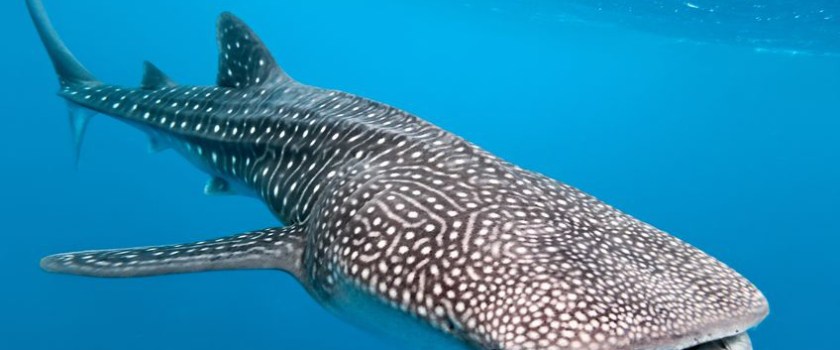Whale sharks eat plankton and are the largest sharks in the ocean!
If you’re going to snorkel at Molokini Crater, it’s great to know something about the sharks who live there. Read below to learn more about these important marine animals.

Whale sharks eat plankton and are the largest sharks in the ocean!
Whitetip Reef Shark (Mano-lala-kea)
Whitetip reef sharks are small and thin (up to approximately 5 feet in length), and are the most common shark you’ll find. During the day, they rest in caves, though they can sometimes be seen out and about. Other sharks must constantly move in order to breathe, but whitetips pump water over their gills and rest in place. At night they feed along Molokini’s reef. This is a safe place for juvenile sharks who may be too small to swim out in the depths alone. Adults are typically found along the bottom.
They like to eat octopus, crustaceans, and fish. Whitetip reef sharks give birth in spring and summer, and mate in the summer and the fall. They are not aggressive toward humans, but they are curious. They will also steal a fisherman’s catch in a heartbeat.
Whale Shark
Whale sharks are frequent visitors to Molokini. Reaching a maximum length of 41.5 feet and a weight of 21.5 tons, whale sharks were named for their size as well as the fact that they are filter feeders who swim on the surface. Whale sharks were first described in Cape Town, South Africa in 1828 by Andrew Smith, a military doctor. They evolved 60 million years ago. Whale sharks are the largest non-cetaceans, and the largest vertebrates, on Earth.
Grey Reef Shark
Although most grey reef sharks live in deeper water, some can be found at Molokini. The grey reef sharks must constantly swim in order to breathe. Greys are larger than whitetips and mate in groups. Grey reef sharks can be found in South Africa, Easter Island, and the Indo-Pacific. They like to hang out near reef ledges, looking for cephalopods and fish. Most have a specific area they habitually return to. During the day, they like to socialize in groups near the drop-off; at night they span out individually to hunt. Grey reef sharks were the first species of shark found to demonstrate a threat display, in which sharks indicate that they are about to attack by hunching their posture and swimming side to side dramatically. They only do this with humans if divers are harassing them, following them, or cornering them (which can happen if a diver enters a shark’s cave and accidentally corners the shark).
